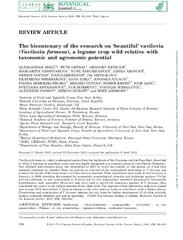Приказ основних података о документу
The bicentenary of the research on 'beautiful' vavilovia (Vavilovia formosa), a legume crop wild relative with taxonomic and agronomic potential
| dc.creator | Mikić, Aleksandar | |
| dc.creator | Smykal, Petr | |
| dc.creator | Kenicer, Gregory | |
| dc.creator | Vishnyakova, Margarita | |
| dc.creator | Sarukhanyan, Nune | |
| dc.creator | Akopian, Janna | |
| dc.creator | Vanyan, Armen | |
| dc.creator | Gabrielyan, Ivan | |
| dc.creator | Smykalova, Iva | |
| dc.creator | Sherbakova, Ekaterina | |
| dc.creator | Zorić, Lana | |
| dc.creator | Atlagić, Jovanka | |
| dc.creator | Zeremski-Škorić, Tijana | |
| dc.creator | Ćupina, Branko | |
| dc.creator | Krstić, Đorđe | |
| dc.creator | Jajić, Igor | |
| dc.creator | Antanasović, Svetlana | |
| dc.creator | Đorđević, Vuk | |
| dc.creator | Mihailović, Vojislav | |
| dc.creator | Ivanov, Alexandr | |
| dc.creator | Ochatt, Sergio | |
| dc.creator | Ambrose, Mike | |
| dc.date.accessioned | 2021-04-26T19:04:04Z | |
| dc.date.available | 2021-04-26T19:04:04Z | |
| dc.date.issued | 2013 | |
| dc.identifier.issn | 0024-4074 | |
| dc.identifier.uri | http://fiver.ifvcns.rs/handle/123456789/1218 | |
| dc.description.abstract | Vavilovia formosa is a relict, endangered species from the highlands of the Caucasus and the Near East. Described in 1812, it has had an uncertain status and was finally recognized as a separate genus of tribe Fabeae (Fabaceae). Our informal international group was established in 2007 to revive the interest in this species as it had been seriously neglected for decades. Here, we provide an overview of the accumulated knowledge on V.formosa and present the results of the most recent multidisciplinary research. Three expeditions were made to two locations in Armenia in 2009, providing the material for anatomical, morphological, chemical and molecular analysis. Unlike previous attempts, ex situ conservation in Yerevan and in vitro propagation, important for potential interspecific hybridization, were successful. Molecular tools were used to clarify the taxonomic position of V.formosa, often considered the closest to the extinct ancestor of the whole tribe. The analysis of four informative regions of plastid and nuclear DNA showed that V.formosa belongs to the same clade as Lathyrus and Pisum, with a distinct status. Preservation and maintenance of V.formosa remains the only basis for further development of all other scientific aspects, especially breeding and uses in agronomy.\ | en |
| dc.publisher | Oxford Univ Press, Oxford | |
| dc.relation | European Union, European Commission, ERA 168/01 SEELEGUMES | |
| dc.relation | Grant Agency of Palacky University [IGA PrF-2012-001] | |
| dc.relation | info:eu-repo/grantAgreement/MESTD/Technological Development (TD or TR)/31016/RS// | |
| dc.relation | info:eu-repo/grantAgreement/MESTD/Technological Development (TD or TR)/31024/RS// | |
| dc.rights | openAccess | |
| dc.source | Botanical Journal of the Linnean Society | |
| dc.subject | biodiversity | en |
| dc.subject | characterization | en |
| dc.subject | ecogeography | en |
| dc.subject | evaluation | en |
| dc.subject | ex situ conservation | en |
| dc.subject | Fabeae | en |
| dc.subject | in situ preservation | en |
| dc.subject | legume evolution | en |
| dc.subject | molecular taxonomy | en |
| dc.title | The bicentenary of the research on 'beautiful' vavilovia (Vavilovia formosa), a legume crop wild relative with taxonomic and agronomic potential | en |
| dc.type | article | |
| dc.rights.license | ARR | |
| dc.citation.epage | 531 | |
| dc.citation.issue | 4 | |
| dc.citation.other | 172(4): 524-531 | |
| dc.citation.rank | M21 | |
| dc.citation.spage | 524 | |
| dc.citation.volume | 172 | |
| dc.identifier.doi | 10.1111/boj.12060 | |
| dc.identifier.fulltext | http://fiver.ifvcns.rs/bitstream/id/165/1215.pdf | |
| dc.identifier.scopus | 2-s2.0-84880645148 | |
| dc.identifier.wos | 000321948800007 | |
| dc.type.version | publishedVersion |


